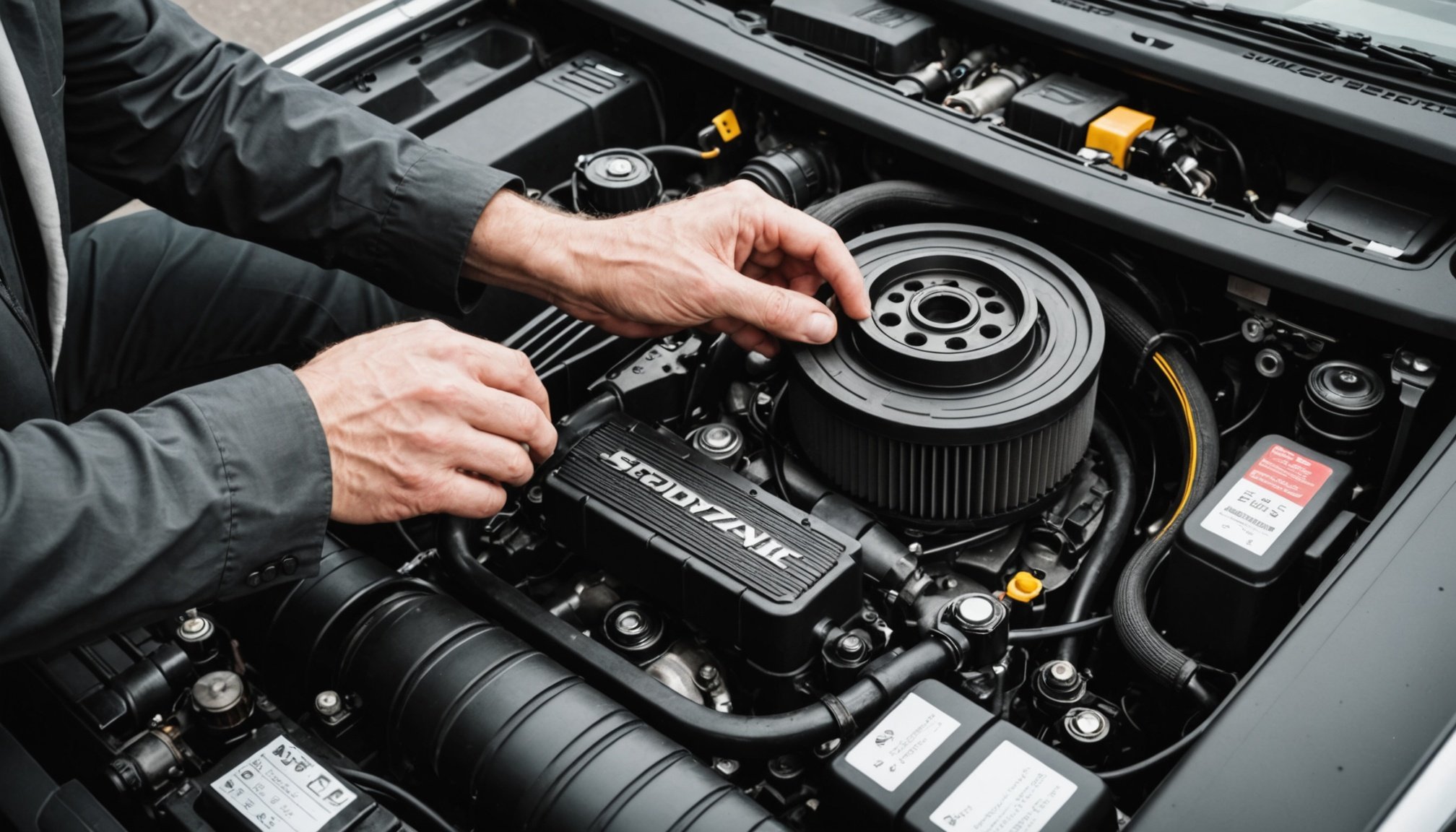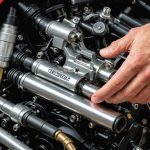Understanding the Serpentine Belt and Its Importance
The serpentine belt is a critical component in any vehicle, especially in a luxury SUV. Its primary function is to drive multiple peripheral devices in the engine, such as the alternator, power steering pump, and air conditioning compressor. Unlike older configurations that used multiple belts, the serpentine belt integrates these roles into a single belt that offers improved efficiency and easier maintenance.
Regular maintenance and timely replacement of the serpentine belt are crucial due to its wear-and-tear nature. Overlooking this component can lead to serious repercussions, including loss of power to essential systems, which could leave you stranded. In luxury SUVs, where performance and reliability are paramount, any failure can be particularly inconvenient and costly.
Have you seen this : Unlocking optimal traction: crucial wheel alignment techniques for your british off-road adventure
Neglecting the serpentine belt can result in catastrophic engine damage. For instance, a broken belt might lead to overheating since it’s unable to drive the water pump. Therefore, understanding the belt’s condition and adhering to manufacturer-recommended maintenance intervals is vital. Ensuring your luxury SUV’s serpentine belt is in good condition not only prolongs the life of your vehicle but also guarantees a smooth and enjoyable ride.
Tools Required for Serpentine Belt Replacement
When preparing to replace a serpentine belt in a luxury SUV, having the right tools is crucial. The essential tools for this task ensure a smooth and efficient replacement process, enhancing both the performance and lifespan of your engine components.
Also to read : Illuminate your classic british ride: the transformative benefits of upgrading to led headlights
Key tools for serpentine belt replacement include a belt tensioner tool to perfectly adjust the tension, ensuring the belt aligns correctly with the pulleys. A socket set is necessary for removing various bolts and components securing the belt in place. Additionally, a serpentine belt tool kit or wrench set assists in navigating the tight spaces typical in luxury SUVs, allowing for easier removal and installation of the belt.
Opting for high-quality tools is recommended to avoid slippage or incomplete tightening, which could lead to poor performance or damage. Brands like Stanley or Craftsman offer durable and reliable options for any DIY enthusiast aiming to tackle this task.
Having the proper tools not only facilitates the belt replacement but also empowers you to perform it safely at home. It ensures you achieve precise tension, reducing the risk of future malfunctions. Investing in quality tools provides longevity in both maintenance projects and your vehicle’s operation.
Step-by-Step Guide to Replacing the Serpentine Belt
Replacing a serpentine belt in a luxury SUV can be a straightforward task with the right guidance. This section offers a clear and comprehensive replacement guide.
Preparing for Replacement
Before you start, ensure you follow essential safety precautions. Always disconnect the battery to avoid electrical hazards. Determine your SUV’s make and model to identify specific belt configurations and tensioner specifications. Gather all required tools, including a belt tensioner tool and socket set.
Step-by-Step Instructions
-
Removing the Old Belt: Begin by locating the belt routing diagram, typically found on a sticker under the hood or in the owner’s manual. Use the belt tensioner tool to relieve tension and carefully slide the old belt off the pulleys.
-
Installing the New Belt: Compare the new and old belts to ensure matching lengths, then follow the routing diagram to loop the new belt around the pulleys. Use the tensioner tool to reapply the correct tension.
-
Ensuring Proper Alignment: Double-check the belt’s alignment on all pulleys and ensure there are no kinks or misalignments before reconnecting the battery. Correct alignment is crucial for optimal performance and longevity of the new belt.
Specific Considerations for Popular Luxury SUV Brands
Understanding the serpentine belt replacement for luxury SUV brands requires attention to each brand’s specific models. Differences in engine layouts and belt routing systems dictate how you approach replacement. For instance, brands like Lexus and BMW often integrate closely packed components, making serpentine belt replacement more intricate than in broader-engine designs.
Some brands use a serpentine belt configuration that demands unique tensioner tools or specialised kits. For example, Mercedes-Benz may require specific sockets to access hidden tensioners. These requirements make knowing your SUV’s make and model vital before you begin any replacements.
Consider brand-specific guidance. Land Rover might advise a different mileage interval for belt replacement than Audi. Adhering to these intervals prevents premature wear and maintains performance. Also, keep an eye on tension levels; some SUVs pack tensioners tightly to maximise space, demanding precise adjustments.
Remember to regularly check for tutorials or manuals provided by the brand. Official resources often highlight brand-centric features that standard guides might overlook. Following these tips ensures you align with manufacturer standards, offering optimal care for your luxury SUV’s serpentine belt.
Cost Considerations for Serpentine Belt Replacement
Understanding the costs associated with serpentine belt replacement in a luxury SUV is essential for effective budgeting. On average, serpentine belt replacement costs can vary significantly between different luxury SUV models. These costs principally divide into parts and labour.
Parts costs: A new serpentine belt typically ranges from £20 to £100, depending on the make and quality. For example, premium brands may have higher pricing due to specific material needs or additional features.
Labour costs: Hiring a professional to replace a serpentine belt often adds £50 to £200 to the bill. This variation is influenced by the complexity of the luxury SUV’s engine design and the shop’s hourly rate.
Budgeting for routine maintenance helps avoid emergency repairs, which can be markedly more expensive. Investing in timely replacements also prolongs the lifespan of engine components, sparing you more significant expenditures later.
By planning for these costs, SUV owners can maintain their vehicle’s performance and dependability. Consider setting aside funds regularly, preparing for both scheduled and unforeseen expenses, ensuring ongoing reliability and peace of mind in your luxury driving experience.
Final Tips for Maintaining the Serpentine Belt
Regular inspection and maintenance of your SUV’s serpentine belt are essential to prevent unexpected issues. Begin by inspecting the belt for visible wear, such as fraying, cracks, or glazing. If you notice any of these signs, consider replacing the belt immediately, even if it’s before the suggested mileage intervals.
Listening for unusual noises, like squealing or chirping, can also indicate a slipping or misaligned belt. In such cases, adjust the tension or consider a replacement. Understanding these warning signs is crucial for preventing more severe engine problems.
Adhering to the manufacturer-recommended mileage will also help in maintaining the belt’s performance. Most luxury SUVs require a serpentine belt replacement between 60,000 and 100,000 miles, depending on the brand and model. However, extreme conditions or heavy usage might necessitate earlier replacements.
To prolong the belt life, avoid exposure to engine oil or coolant leaks, which can weaken the belt over time. Opt for OEM-quality belts that match your vehicle’s specifications to ensure durability and reliability.
These maintenance strategies will keep your luxury SUV running smoothly, affirming its performance and enhancing the longevity of your vehicle.











